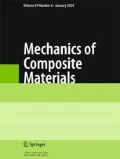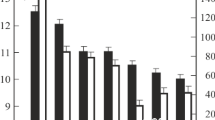Abstract
A concept of physical and chemical stages of interaction between the matrix and reinforcing fibers during the production of composite materials is introduced. A strong bond between these constituents is formed at the stage of chemical interaction, which is characterized by a certain value of activation energy. The activation energy of such an interaction for high-strength high-modulus polyethylene fibers used for reinforcing composites is estimated. Based on these estimates, conditions for fiber activation with “cold” plasma are found. The application of plasma-activated polyethylene fibers for reinforcing an epoxy matrix allows one to produce light-weight composites with high physicomechanical indices. The failure mode of such composites points to a high strength of the bond between the fibers and matrix. The data on treating the fiber surface with “cold” plasma above the activation energy of chemical interaction may be utilized to create new types of organic composites from other kinds of organic fibers and matrices.
Similar content being viewed by others
REFERENCES
Pat. No. 7900990, the Netherlands (1979).
E. F. Kharchenko, A. S. Chervyakov, and P. E. Fatin, “Manufacturing of extra-light organic plastics based on high-oriented polyethylene fibers,” Plast. Massy, No. 5, 13-15 (1992).
V. V. Kudinov, Plasma Coatings [in Russian], Nauka, Moscow (1977).
S. A. Gordeev, V. G. Alekseev, B. A. Tsaplin, and N. M. Bal'bit, “Properties of a high-strength polyethylene filament subjected to radiation-chemical modification,” Khim. Volokna, No. 3, 21-24 (1995).
C. Leone, G. Caprino, I. De Iorio, L. Nele, and V. Tagliaferri, “Improving polymeric fibre-matrix interface by cold-plasma surface treatment,” in: Proc. 9 Europ. Conf. Compos. Mater.: Composites - from Fundamentals to Exploitation, Brighton, UK, June 4-7, 2000, Book of Abstracts, Ed. by IOM Communications Ltd is a wholly owned subsidiary of the Institute of Materials, Registered Charity Number 1059475, Brighton, UK (2000).
K. E. Perepelkin, Structure and Properties of Fibers [in Russian], Khimiya, Moscow (1985).
V. V. Voevodskii, Physics and Chemistry of Elementary Chemical Processes [in Russian], Nauka, Moscow (1969).
V. I. Kuzub, V. N. Kaminskii, S. A. Gordeev, A. N. D'yachkov, Yu. I. Mitchenko, and A. S. Chegolya, “Properties of high-strength high-modulus polyethylene fibers,” Khim. Volokna, No. 2, 31-32 (1989).
V. R. Regel', A. I. Slutsker, and E. E. Tomashevskii, Kinetic Nature of the Strength of Solids [in Russian], Nauka, Moscow (1974).
Yu. M. Tarnopol'skii and T. Ya. Kintsis, Methods for Static Tests of Reinforced Plastics [in Russian], Khimiya, Moscow (1975).
S. Bazhenov, “Interlaminar and intralaminar failure modes in a 0/90 cross-ply glass/epoxy laminate,” Composites, 26, 125-133 (1995).
Author information
Authors and Affiliations
Rights and permissions
About this article
Cite this article
Korneeva, N.V., Kudinov, V.V., Bazhenov, S.L. et al. New Potentialities in Producing Composites Reinforced with High-Strength High-Modulus Polyethylene Fibers. Mechanics of Composite Materials 38, 555–560 (2002). https://doi.org/10.1023/A:1021734811034
Issue Date:
DOI: https://doi.org/10.1023/A:1021734811034




